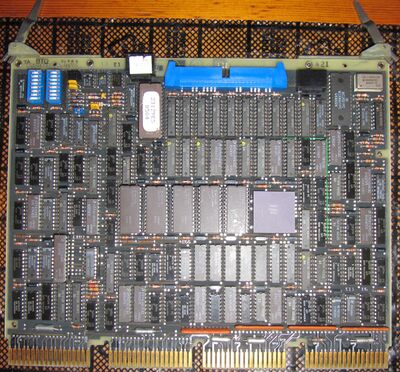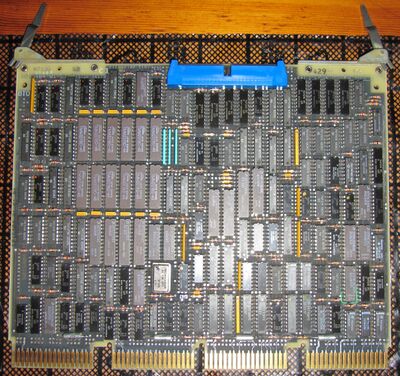Difference between revisions of "MicroVAX I"
m (→MicroVAX I Communication Options: Empty link removed) |
m (fix 'VAXstation I' link, bad category) |
||
| Line 20: | Line 20: | ||
}} | }} | ||
| − | The [[Digital Equipment Corporation|DEC]] '''MicroVAX I''' was the first of a lot of [[MicroVAX]] models. | + | The [[Digital Equipment Corporation|DEC]] '''MicroVAX I''' was the first of a lot of [[MicroVAX]] models. It was said to be the slowest [[VAX]] ever (about 0.25 [[VUPS]]), even slower than the [[VAX-11/730]] resp. [[VAX-11/725]]. |
| − | It was said to be the slowest [[VAX]] ever (about 0.25 [[VUPS]]) , even slower than the [[VAX-11/730]] resp. [[VAX-11/725]]. | ||
| − | With a [[VCB01]] Monochrome Video Subsystem added, the MicroVAX I becomes a [[ | + | With a [[VCB01]] Monochrome Video Subsystem added, the MicroVAX I becomes a [[VAXstation I]]. |
==MicroVAX I CPU== | ==MicroVAX I CPU== | ||
| − | The '''KD32''' MicroVAX I CPU consists of two quad height [[ | + | The '''KD32''' MicroVAX I CPU consists of two quad height [[QBUS]] cards: |
[[File:M7135_DATAPATH.JPG|400px|thumb|left|M7135 MicroVAX I Data Path Module (DAP)]] | [[File:M7135_DATAPATH.JPG|400px|thumb|left|M7135 MicroVAX I Data Path Module (DAP)]] | ||
| Line 46: | Line 45: | ||
* An 8 KB direct-mapped cache | * An 8 KB direct-mapped cache | ||
* A 512 entry (longword) translation buffer | * A 512 entry (longword) translation buffer | ||
| − | * A 10 ms | + | * A 10 ms non-programmable interval timer |
* An interface to a console serial line unit (available Baud Rates: 300, 1200, 9600, 19200) | * An interface to a console serial line unit (available Baud Rates: 300, 1200, 9600, 19200) | ||
* An 8 KB or 16 KB boot EPROM | * An 8 KB or 16 KB boot EPROM | ||
| Line 183: | Line 182: | ||
<div id="ref_1">[1] MicroVAX Handbook. EB-25156-47</div> | <div id="ref_1">[1] MicroVAX Handbook. EB-25156-47</div> | ||
<div id="ref_2">[2] Systems & Options Catalog. European Edition. Spring 1990. </div> | <div id="ref_2">[2] Systems & Options Catalog. European Edition. Spring 1990. </div> | ||
| − | |||
| − | |||
{{Nav VAX}} | {{Nav VAX}} | ||
Revision as of 08:00, 15 June 2022
| MicroVAX I | |
| Summary | |
|---|---|
| Announcement date: | October 1983 |
| FRS date: | late 1984 |
| Codename: | Seahorse |
| OS support (VMS): | MicroVMS V1.0 to VMS V5.0-2 |
| OS support (ULTRIX): | ULTRIX/VAX V1.0 to ULTRIX/VAX V2.4? |
| CPU Details | |
| CPU module: | KD32-AA |
| Number of processors: | 1 |
| Translation-buffer: | 512 entries [1] |
| Cache: | 8KB |
| Compatibility mode: | No |
| Console processor: | CPU |
| Console device: | None |
| Memory | |
| Minimum memory: | 512KB |
| Maximum memory: | 4MB |
| I/O | |
| Q-bus: | 1 @ 3.3MB/s |
| LAN support: | optional |
The DEC MicroVAX I was the first of a lot of MicroVAX models. It was said to be the slowest VAX ever (about 0.25 VUPS), even slower than the VAX-11/730 resp. VAX-11/725.
With a VCB01 Monochrome Video Subsystem added, the MicroVAX I becomes a VAXstation I.
Contents
MicroVAX I CPU
The KD32 MicroVAX I CPU consists of two quad height QBUS cards:
- Data Path Module (DAP) M7135
- Memory Controller Module (MCT) M7136
The two CPU modules of the MicroVAX I communicate over the CD interconnect of the H9278 backplane interconnect and an over-the-top ribbon cable.
The KD32 CPU contains:
- An interface to the Q22 bus which supports block mode transfers and up to four megabytes of physical memory
- An 8 KB direct-mapped cache
- A 512 entry (longword) translation buffer
- A 10 ms non-programmable interval timer
- An interface to a console serial line unit (available Baud Rates: 300, 1200, 9600, 19200)
- An 8 KB or 16 KB boot EPROM
- Interfaces to the front control panel and rear patch panel assembly
MicroVAX I Boot ROM
Boot ROM Restrictions
The MicroVAX I bootstrap ROM can only bootstrap a system disk attached to the first Mass Storage Control Protocol (MSCP) controller.
See the instructions from: AA-KM46A-TN MicroVMS 4.6 Installation and Operations, Chapter C.1 Creating a Console Diskette:
The console diskette will contain files used to bootstrap from a disk attached to the second MSCP controller. Use the following steps to create a console diskette. This example assumes that the first RC25 disk attached to the second MSCP controller (DABO) will be the new system disk:
- Log in to the system manager's account, SYSTEM.
- Check the first diskette drive to ensure that it is empty and inactive; the red diskette activity light should not be glowing. If there is a diskette in the drive, remove it following the instructions in Section 3.1.11.
- Label a scratch diskette CONSOLE DISKETTE. A scratch diskette is a new diskette or a diskette containing no information that you want to save.
- Enter the following command to invoke the command procedure that creates a console diskette for a MicroVAX I system:
-
$ @SYS$UPDATE:VMBUVAX1
- What system disk do you want to be able to boot from? DABO
- Ignore the informational messages displayed on your terminal screen. The procedure prompts you for the name of the diskette drive on which the intermediate media (console diskette) will be mounted. In this example, the media is mounted in diskette drive 1 (DUA1).
-
Where will the intermediate RX50 media be mounted? DUA1
- Insert the diskette labeled CONSOLE DISKETTE into drive 1 and enter YES in response to the following prompt:
-
Are you ready? YES
- When it has finished building the console diskette, the system displays the following message:
-
The media on DUA1 may now be used to boot device DABO
After you create the console diskette, write-protect it to prevent anyone from accidentally overwriting the contents. To write-protect a diskette, cover the square notch in the upper-right comer of the diskette with a silver tab. Note that in order to bootstrap the system, the console diskette must be in diskette drive 1.
You may want to add the following command to the end of SYS$MANAGER:SYSTARTUP.COM to mount the console diskette automatically every time you bootstrap the system. This prevents other users from removing the diskette thinking that the drive is not in use.
$ MOUNT/SYSTEM/FOREIGN $FLOPPY1 INTERMEDIATE
NOTE
The command procedure SYS$UPDATE:VMBUVAX1.COM and other files needed might not be on the system disk depending on the option used when the systen was installed.
You can install the missing components using:
$ @SYS$UPDATE:VMSINSTAL UTIL $TAPE1:
The tape (resp. tape image) AQ-FP13D-BN_MICROVMS_4.6_87 must be loaded (resp. attached to) the TK50 tape drive beforehand.
Answer all questions with N:
* Do you want to install the entire kit: N * Do you want to install the MAIL utility: N * Do you want to install the SEARCH utility: N * Do you want to install the DIFF utility: N * Do you want to install the DUMP utility: N * Do you want to install the RUNOFF utility: N * Do you want to install the PHONE utility: N * Do you want to install the MicroVMS HELP library: N * Do you want to install the Remote terminal support via SET HOST/DTE: N * Do you want to install the Foreign Terminal Support: N * Do you want to install the LAT-11 terminal server support (via Ethernet): N * Do you want to install the Stand-alone backup on system disk support: N
except for:
* Do you want to install the MicroVAX-I bootstrap that works for any MSCP system device: Y
You should now be able to set up the special boot diskette for booting from a disk attached to the second MSCP controller.
Supported Boot Devices
Boot ROM Characteristics
- Microverify is the name given to the diagnostics executed by the MicroVAX I boot ROM. There are three LEDs on the DAP module and a seven segment display on the patch panel which will isolate the problem (if any) to one of the two CPU modules.
- Floating Point Instructions in Microcode
- No TOY Clock
MicroVAX I Options
There are a lot of MicroVAX I Options; some of them are not "officially supported", but working nevertheless.
MicroVAX I Memory Options
The MicroVAX I uses standard Q-bus memories which are not as fast but are also less expensive and usable by both the MicroVAX I and other 16-bit processors (such as the MicroPDP-11). There are 22 address lines on the Q-bus, limiting maximum memory to 4 MB.
- MSV11-P Parity Memory
- MSV11-J PMI ECC Memory: not supported, but working!
- MSV11-Q Parity Memory
- MSV11-M Parity Memory
MicroVAX I Mass Storage Options
- RQDX1
- RQDX2
- RQDX3
- RX50
- RD51
- RD52
- RD53
- RD54
- RD31
- RD32
- RQC25 RC25 Disk System with Qbus Controller, made of:
The SIMH MicroVAX I supports the RLV12 controller for RL01 and RL02 removable disks.
It is currently unknown/untested whether the 'real' MicroVAX I supports the RLV12 controller as well.
Anyway, booting from an RL01/RL02 is not supported by the MicroVAX I boot ROM.
MicroVAX I Communication Options
MicroVAX I Video Options
- VCB01 Monochrome Video Subsystem
MicroVAX I Configuration
MicroVAX I Diagnostics
MicroVAX I is the only MicroVAX model with "old-style" VDS (Vax Diagnostic Supervisor) diagnostics.
ATTACH ...
References
| v • d • e VAX Computers and Operating Systems |
|---|
| VAX-11/7xx (including VAX 86x0) - VAX-11/780 • VAX-11/785 • VAX-11/750 • VAX-11/730 • VAX-11/725 • VAX 8600 • VAX 8650
VAX 8000 series (excluding VAX 86x0, above) - VAX 82xx/83xx series • VAX 85xx/87xx/88xx series MicroVAXen (many types also come in VAXserver and VAXstation models) - MicroVAX I • MicroVAX II VAXstation Series - VAXstation I • VAXstation II Late Model VAXen - VAX 4000 series • VAX 6000 series • VAX 7000 series • VAX 9000 series • VAX 10000 series |
| Special Purpose VAXen - VAXft series • rtVAX series • Infoserver series
Clones - CM 1700 • TPA-11/580 |

